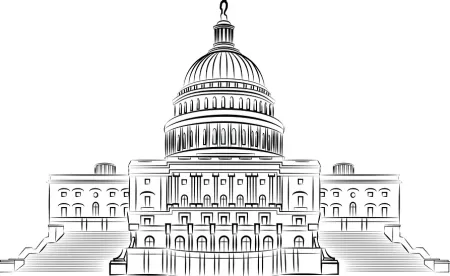Debt Ceiling Disaster Dodged.
After months of political posturing, weeks of negotiating, and days of nail-biting, the U.S. Congress approved legislation to lift the debt limit to ensure continued payment of the nation’s bills. The Fiscal Responsibility Act of 2023 (H.R. 3746) passed the U.S. House of Representatives on May 31, 2023, by a vote of 314–117, and it passed the U.S. Senate on June 1, 2023, by a vote of 63–36. One hundred sixty-five Democrats joined 149 Republicans to get the bill across the finish line in the House, and 44 Democrats, 2 Independents, and 17 Republicans voted for the bill in the Senate. According to a report by the nonpartisan Congressional Budget Office, the measure will reduce the nation’s debt by about $1.5 trillion (over ten years) and save $188 billion in interest payments on the debt. The legislation accomplishes these savings by:
- suspending the debt ceiling until January 1, 2025;
- placing caps on discretionary spending (i.e., not Medicare/Medicaid or Social Security) for the 2024 and 2025 fiscal years;
- rescind about $27 billion of unspent COVID-19 federal relief funds that had been provided to nearly ninety budget accounts;
- recouping $1.4 billion appropriated for the Internal Revenue Service as authorized by the Inflation Reduction Act of 2022;
- enacting work requirements for the Temporary Assistance for Needy Families (TANF) program and Supplemental Nutrition Assistance Program (SNAP, or food stamps); and
- lifting the COVID-19 student loan pause.
NLRB GC Targets Noncompete Agreements.
Noncompete agreements remain a popular target for policymakers in Washington, D.C. The Federal Trade Commission has its proposal to ban noncompete agreements and Congress has the Workforce Mobility Act, a bill proposed this year in February. Now, National Labor Relations Board (NLRB) General Counsel Jennifer Abruzzo, through a memorandum issued on May 30, 2023, writes that she believes “[e]xcept in limited circumstances … the proffer, maintenance, and enforcement of” noncompete agreements violates the National Labor Relations Act. General Counsel Abruzzo’s theory is that noncompete provisions limit employees’ job opportunities, and thus chill employees:
- “from concertedly threatening” to quit their current job—or actually quitting—to demand better working conditions;
- “from concertedly seeking or accepting employment with a local competitor to obtain better working conditions”;
- “from soliciting their co-workers to go work for a local competitor as part of a broader course of protected concerted activity”; and
- “from seeking employment, at least in part, to specifically engage in protected activity with other workers at an employer’s workplace” (such as organizing a union at another employer’s workplace).
General Counsel Abruzzo suggests that narrowly tailored agreements designed to protect proprietary or trade secret information may be appropriate, but that avoiding competition from a former employee or an employer’s interest in retaining employees or protecting investments in training are unlikely to justify an over broad noncompete provision. The Board will have to adopt the general counsel’s theory in order for this to become Board policy. Jennifer G. Betts, Tobias E. Schlueter, Thomas M. Stanek, Christine Bestor Townsend, and Zachary V. Zagger have the details.
White House Holds Meeting on Employee Monitoring.
Last week, the White House convened a meeting of policymakers and stakeholders “on the use of automated technologies by employers to surveil, monitor, evaluate, and manage their workers.” The meeting included White House officials, as well as officials from the U.S. Equal Employment Opportunity Commission, NLRB, and the Consumer Financial Protection Bureau. Scrutinized industries included “call centers, trucking, warehousing, home health care, and app-based ride sharing.” The meeting follows on the issuance of a request for information from the White House Office of Science and Technology Policy (OSTP) seeking “comments from the public to better understand automated surveillance and management of workers, including its prevalence, purposes, deployment, and impacts, as well as opportunities for Federal agencies to work with employers, workers, and other stakeholders to ensure that these systems do not undermine workers’ rights, opportunities, access, health, or safety.” Those comments are due by June 15, 2023.
DOL Issues Letter on Calculating FMLA Leave.
Fresh off the Memorial Day holiday weekend, on May 30, 2023, the U.S. Department of Labor’s Wage and Hour Division issued an opinion letter on “how to calculate the amount of leave used when an employee takes leave under the Family and Medical Leave Act (FMLA) during a week with a holiday.” The letter first clarifies that because the actual workweek is the basis for employees’ leave entitlement, when an employee takes a full workweek of FMLA leave during a week that includes a holiday, the entire week counts as FMLA leave. However, if the employee takes intermittent leave (i.e., less than a full workweek), “the holiday is not counted as FMLA leave unless the employee was scheduled and expected to work on the holiday and used FMLA leave for that day.” The letter concludes that the holiday must be counted as part of the workweek when calculating the amount of FMLA leave used in order to avoid reducing the employee’s leave amount: “if the employee was not expected or scheduled to work on the holiday, the fraction of the workweek of leave used would be the amount of FMLA leave taken (which would not include the holiday) divided by the total workweek (which would include the holiday).”
Anniversary of Codification of Native American Citizenship.
Ninety-nine years ago today, President Calvin Coolidge signed into law the Indian Citizenship Act of 1924, which granted birthright U.S. citizenship to all Native Americans. Although the 14th Amendment—ratified in 1868—provides, “All persons born or naturalized in the United States, and subject to the jurisdiction thereof, are citizens of the United States and of the State wherein they reside,” it was interpreted at the time to exclude Native Americans. Eventually, Representative Homer P. Snyder (R-NY), who chaired the House Committee on Indian Affairs, introduced and championed the bill that eventually became the law, which states: “That all non-citizen Indians born within the territorial limits of the United States be, and they are hereby, declared to be citizens of the United States: Provided, That the granting of such citizenship shall not in any manner impair or otherwise affect the right of any Indian to tribal or other property.” The timing of the legislation owed, in part, to a recognition of the contributions of thousands of Native Americans during World War I.




 />i
/>i

